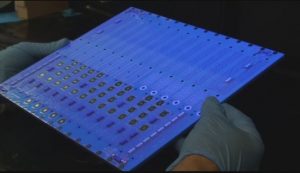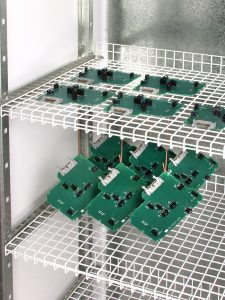Setting up a turn key conformal coating production line
The set up of a turnkey conformal coating production line, whether it is a batch or inline process, has many similar characteristics whatever the application process required. 
Whether the conformal coating application is based around a high volume selective coating robot or a batch dip coating machine the rules and requirements tend to be the same. Follow some simple guidelines and it can avoid a lot of problems later on.
General requirements
Any coating facility will need the basic requirements put in place that would be standard for any piece of electronic manufacturing process. These include ESD systems, facilities for the machines, the environmental requirements and the normal Health & Safety (HSE) considerations. The first two are straightforward and are not considered here. However, the last two need to be considered in more depth.
Health & safety (HSE)
HSE tends to be more important for conformal coatings since in general the coatings themselves are hazardous, or the way they are applied makes them potentially harmful to operators. If they are solvent based coatings, then extraction to remove the fumes is very important. Most equipment will have minimum requirements for extraction to be fitted and these guidelines should be followed.
If the coatings are not solvent based, then there can be other hazards. A popular conformal coating method of application is UV cure. However, two hazards immediately come out in this technology. The first is the UV light itself since it is highly harmful to people if seen and therefore shielding has to be good around the UV cure system. This can be seen in figure 1 where the UV light is very intense.
The second hazard in UV curing is the ground level ozone which can be created during the UV cure process . Again, this is highly dangerous to operators and extraction is needed to remove it from the area.
Beyond UV cure there is also spraying of conformal coating. Atomising a liquid, even if it is not solvent based, can be hazardous to operators and their lungs. Therefore, the equipment used, and more importantly, the way the ventilation works around this equipment is very important.
So, if extraction is required then it is critical to follow the local HSE advice on how this is fitted and the type of extraction and the machine manufacturers recommendations.
Environment considerations
Conformal coatings are sensitive to the environment that they are processed in. The coating room area should logically be clean & dust free since PCBs are susceptible to particles sticking to the drying coating. What level of cleanliness is needed is down to the requirements of the customer or manufacturer. However, the cleaner the facility, the fewer the issues there are in meeting manufacturing standards like the IPC-A-610 and fewer conformal coating defects are created.
Other environment factors are also important. The temperature range within the coating room should be reasonably controlled within sensible limits since the viscosity of the conformal coating will vary with temperature. This can really disrupt a coating line where a change in viscosity due to large room temperature changes can adjust the coating application and performance.
Another critical point is the humidity. This may need to be controlled to be above 35% (for ESD reasons) and less than 55-60% due to moisture issues. This is because having a high humidity can affect the coating integrity and the application method producing dull coating thickness and entrapping moisture within the coating itself.
Production line requirements
The actual conformal coating production line, whether this is an operator brush coating printed circuit boards (PCBs) or an inline spray coating process can be made up of several stages (not all are mandatory). The standard stages that this could be comprised of are shown in figure 2.

Figure 2: Flow diagram of the key stages of a conformal coating production line
As stated not all of these stages may be required and it may be a very simple process. But, we will explore each of the stages in turn to review the options for an engineer when setting up a coating production line.
Consider each of the stages and the impact they have for setting up the facility:
Boards in / Boards out
This is very straightforward. The PCBs delivered to the coating area ready for processing.
Incoming inspection
Inspecting the PCBs before starting the process helps stop the line if there is a problem before too much work has been done upstream. It also identifies which PCBs are to be coated, the material to be used and how they are to be coated. This can be done automatically as part of the production process or completed by the operator.
Cleaning
Cleaning circuit boards before coating may or may not be required. This is a decision that has to be made earlier on perhaps in the design stage before production actually starts. The cleaning protocol is for the engineers to decide.
However, if you do clean it is it may be worth considering a few guidelines
- Ensure that the cleaning process does not add more contaminants to the PCB than it started with. For example, make sure the rinsing of the cleaning fluid from the PCB is successful and that the rinse water is DI water and high enough purity not to add ionic contaminants to the PCBs
- The PCBs are dry enough for the coating process and not leave water entrapped under components which could impede the coating application.
- If the intention is to clean then ensure the cleaning process actually removes residues that cause defects like de-wetting to minimise finishing at the end of the process
Again, this is for the engineers to decide and the consideration of whether you need to clean your circuit boards for conformal coating is a whole topic on its own.
Masking
Masking may not be required. However, there are very few circuit boards in the world that can be completely coated all over and have no areas that must not be coated. Some components on PCBs generally need to avoid having conformal coating applied to them and therefore this gives the engineers two options:
You can avoid coating the component or area using a selective spray or dip system.
You can apply some form of masking that the coating can be applied to and remove the masking materials after application.
Again, engineers need to consider their options on whether to use conformal coating masking.
Pre-coating inspection
In our coating services around the world we have found it is more efficient to double check the masking process is correct before coating application rather than repair the PCB after the process goes wrong because masking was incorrect. This check can be manual or automated but it is highly valuable.
Conformal coating application
The one stage that cannot be avoided is the conformal coating applied to the PCB. There are many different methods for applying conformal coatings and probably the most important factor in all of them is training. The operator needs to understand the process to be able to work correctly.
Here are a few key points on the most popular methods:
Brush application
Brush coating appears to be one of the simplest methods in conformal coating application. However, it is not easy to do well without training . With good technique it is possible to be highly effective and meet all the requirements of standards like the IPC specification.
Key points include:
- Create an environment suitable for brushing that is similar to the finishing and inspection stages . Good UV lighting and extraction (solvent based coatings) can make a massive difference in performance of operators over a period of time.
- Train the operator to develop the brush coating technique to minimise defects that are easily created if the coating is applied wrongly.
- Control the viscosity of the conformal coating as this may change with time and again lead to poorer application performance.

Figure 4 : It is critical to create the right environment for brushing conformal coating
Dipping application
Dip coating can be hand dipping in a tub of conformal coating or a more formal controlled process using a conformal coating dipping system.
In terms of process the key factors for control of coating application during dipping are viscosity and withdrawal speed of the PCBs from the liquid. If you control these factors then you can control the coating thickness on the circuit board. However, it is important to remember that the conformal coating viscosity is intimately related to the temperature and other environmental factors.
Finally, also consider that if you are using a dip system how you handle the dripping PCBs and the control of the evaporating solvents if the coatings give off fumes.
Batch spraying / aerosol application
When spraying with an aerosol or a spray gun in a spray booth there are several key points to consider.
- The dominant factor is operator training. This is a semi skilled process and the application of conformal coating by hand spray is not simple.
- In general, it is far better to apply several thin layers of coating than one thick layer. This is due to problems like bubbles entrapment and skinning of the coating.
- You can achieve a great finish with spraying if the operator is skillful. You can also minimise your processing after application in de-masking and touch up if the coating is applied correctly.
- Finally, the coating thickness is controlled by the operator so ultimately good training is crucial and a method for monitoring conformal coating thickness application is developed .
Selective robot application
Robotic coating is the dominant application method in conformal coating for high volume production. It can eliminate or minimise masking needs, especially if the PCB is designed for the process. Again, key factors include operator training in the use of the system since ultimately it can be a complex machine and to get the best from it requires the operator to understand the process.
Drying / curing
A conformal coating is a wet process and therefore the coating has to dry. The difference between drying and curing is explored elsewhere. However, the process required depends on the coating itself. 
For example, a solvent based acrylic coating will dry be evaporating the solvents away from the PCB. During this time the PCB is wet and could get contaminated by airborne particulates or be accidentally touched by operators. So, either the machine itself or the conveyors need to shield it from the environment or the PCBs need to be stored away until dry.
However, if the coating needs curing fast, with UV light or heat for example, then an extra process and production systems such as UV light conveyors or inline infrared convection ovens need to be included.
De-masking
Like masking, there is skill in removing the masking materials and ensuring the final finished PCB is fit to pass the inspection criteria. Work instructions are needed along with training on the specific methods of finishing to ensure this can be achieved.
Again, the work environment is critical and creating the correct area really helps.
Inspection
Ultimately, when the PCB is coated and finished, you want to know if the product meets the inspection criteria. This conformal coating inspection can be done manually or automatically depending on the volume of PCBs and the level of sophistication required. Again, it is down to operator training and using the right equipment to ensure that this is possible.
Also, at this stage it is possible to measure factors like coating conformal thickness to check that the criteria are met. There are coating conformal thickness measurement systems available to do this that if used correctly will give you very accurate readings.
Summary
Setting up a conformal coating facility is a straight forward process as long as all factors are considered. In general, the two key factors are operator training and the control of the environment.
Get this right and many of the problems that could occur during production will be avoided. After training, setting the facility up correctly with the right systems, tools and process controls also ensures a smooth running production.
Figure 5: Drying PCBs in a safe, clean environment after coating application can avoid problems during inspection (insert image)
Brochures
Setting up a conformal coating production line

